A brief history of local buses in the Helsinki Region
Contents
-
History
- The early days
- After the wars
- The regional ticket system
-
Recent changes
- Competitive tendering and privatization
- The floor height revolution
- The electronic ticket system
-
Current trends
- Plans for the future
- Troubled times
- Glossary
- Sources
History
The early days
Local bus traffic started in Helsinki in the 1920's. Many other parts of the country got their first bus routes nearly ten years earlier, as the existing electric tram network made uneconomical to operate buses in Helsinki. The early routes were mostly short regional routes to the edges of Helsinki and the neighbouring towns and villages and were usually operated by individual entrepreneurs or small companies with only a few owners.
After the depression in the first half of the 30's, Helsinki's internal bus traffic also started to grow rapidly. The traffic was operated mostly by Helsingin Raitiotie- ja Omnibus-Osakeyhtiö (Helsinki Tram and Bus Company), in which the city was a majority owner. Several other companies were merged into HRO in 1937 and 1938. In 1939 just before the beginning of the Winter War HRO had 103 diesel buses and twenty petroleum powered buses. The most common makes were Büssing (70) from Germany and Scania-Vabis (20) from Sweden.
After the wars
The Winter and Continuation wars struck bus operations severely. The army took over more than half of all buses and many of those that were left were converted into trucks in order to transport critical supplies. Practically all civilian vehicles were fitted with wood gas converters as liquid fuels were not available. Tires were also in short supply.
After the war ended in 1944, the city decided to take over HRO and the municipal transport department Helsinki City Transport (Helsingin Kaupungin Liikennelaitos, HKL) was founded. Initially the company had only 17 buses left and it took until 1949 before larger amounts of new buses could be bought. Trolleybuses were also taken into use in 1949 on route 14 and were used until 1985.
The regional ticket system
A law change in 1985 placed the Helsinki Metropolitan Area Council (Pääkaupunkiseudun yhteistyövaltuuskunta, YTV) in charge of regional public transport routes in Helsinki, Espoo, Vantaa and Kauniainen. A flat rate regional ticket was introduced and YTV took charge of route planning and route permits. The actual routes were operated by both municipal companies (Espoon Auto, Vantaan Liikenne and HKL) and private companies. All internal routes were planned by the cities and operated under contracts. Internal tickets were made valid inside the specific town on regional routes. Helsinki trams, the metro and the ferry to Suomenlinna were also included in the regional ticket system just like they were included in Helsinki's own ticket system.
Technically the regional ticket and new internal tickets were implemented as Almex stampable cardboard tickets and cardboard season passes in plastic sleeves. A special tariff sign was also introduced for the front of regional buses. Helsinki and Vantaa routes kept their existing signs and Espoo got a common sign, which was later replaced by the regional sign even for internal routes.
Recent changes
Competitive tendering and privatization
Bus route operating contracts in and around Helsinki were considered highly profitable. In an attempt to lower costs and improve service, YTV started to award contracts based on competitive tendering in 1995. Espoo, Vantaa and Helsinki all followed in time. The adopted tendering model means that the cities and YTV collect the fares and pay the operators a certain sum for operating the routes with buses that meet specific requirements. Each time a route or group of routes is up for tendering, the ordering party specifies the minimum requirements and extra points given for better equipped vehicles. The most points are of course awarded for the price, which is divided into vehicle days (use of a specific bus on a specific day), vehicle hours and route kilometres. Operating contracts are generally made for four to seven years at a time.
With the beginning of competitive tendering, Espoo and Vantaa decided to sell their municipal transport companies. Espoon Auto and the privately owned Transbus were bought by Swebus from Sweden in 1995 and 1994 respectively. Swebus was bought by the Scottish Stagecoach group in 1997, which in turn sold its Nordic operations in 2000 and the Concordia Bus group was created. Vantaan Liikenne was sold to the Swedish Linjebuss in 1994, which in turn was sold to CGEA (part of Vivendi-Universal) from France in 1998. The company is now part of the international Connex Group, which is owned by the global Veolia Environnement, former Vivendi Environnement. Helsinki merely separated the bus part of HKL into a separate unit called HKL-Bussiliikenne and did not privatize it. Helsinki also owns practically all of Suomen Turistiauto (STA), which is a limited company.
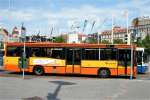 From Vantaan Liikenne.. |
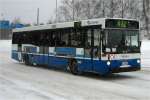 ..to Linjebuss.. |
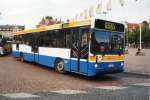 ..to Connex. |
Harsh competition has killed many traditional bus companies in and around Helsinki. These include Metsälän Linja Oy, Oy Liikenne Ab (then part of Koiviston Auto) and Keskuslinja Oy. Other smaller operators have survived, including Åbergin Linja and Westendin Linja from Espoo and Tammelundin Liikenne from Helsinki. Saaren Auto was bought by the state owned Pohjolan Liikenne -group and Lähilinjat was bough by Koiviston Auto, which operates across the country. Many others were merged into Espoon Auto or Vantaan Liikenne before they were sold abroad.
The floor height revolution
Nearly all the buses used in the Helsinki Metropolitan Area had high floors until 1992. The middle engined Volvo B10M was very popular and two steps at each door was the norm. A few exceptional buses had semi low floors with only one step at the front and middle doors and Tammelundin Liikenne introduced their first low floored Mercedes-Benz buses in 1990. HKL tried several low floored alternatives and kept the Scania/Wiima K202 test bus they introduced in 1991. Vantaan Liikenne soon followed suite in 1992 with several Scania/Carrus City L's. HKL also bought a Volvo/Carrus City L in 1992 and in 1994 they bought several Scania/Carrus City L's. Soon almost all the bus operators were buying low floored buses and the pace only grew with competitive tendering, which favoured low floored buses.
 Prototype 1 |
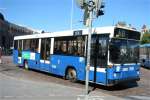 Prototype 2 |
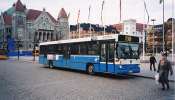 Perfection |
Currently most of the buses used in the Helsinki Region have low floors. New high floored buses are not accepted in operating bids with the exception of some routes in the more remote parts of Espoo. An unfortunate side effect of low floors is that articulated buses have all but disappeared as low floored articulated buses are expensive to operate and have very few seats, which counts as a disadvantage in the tendering process. The long (14,5-15 metres) bogie buses that have replaced articulated buses have less standing space and are less manouverable on routes in the city centre. High floored articulated buses with lots of standing space could still easily defend their place in rush hour operations on some Helsinki routes.
The new Helsinki trams that have been arriving since 1998 also have 100% low floors. New local trainsets have 50-70% low floors and the Helsinki metro has always had lift access to all of its stations.
 Low. |
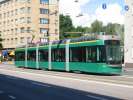 Low. |
 Low |
The electronic ticket system
The cardboard Almex system without magnetic strips was already rather old in 1986 when the regional ticket was taken into use. Koskilinjat Oy in Oulu had successfully deployed their Buscom contactless smart card system in 1992 and several other towns soon followed. YTV also tested different smart card based ticket systems as early as 1992 to 1993. A special project group was founded in 1994.
Buscom Oy from Oulu and Olivetti were chosen as the device contractors in 1996 with half a dozen other companies delivering software, ticket vending machines and other services. The project was delayed by disagreements between YTV and the cities and between the different contractors. The first driver terminals for selling new thermally printed tickets were taken into test use in 1997. All vehicles were fitted with them in early 2000. The first test tickets were introduced in 2001 and the first normal users received their tickets in September 2001. Nearly all types of Almex tickets were finally decommissioned in the beginning of April 2003. The only remaining tickets and stamping machines are used in trams for prepurchased single trip tickets. These will probably be replaced completely by mobile phone based tickets in the near future.
Helsinki is the first capital city in Europe to use a complete smart card system. The system is also very complicated as the cities insisted on keeping nearly all of the old ticket types in the new system. This means that each smart card or Travel Card can simultaneously contain value (money) for purchasing single tickets and two non-overlapping internal or regional season passes. The lenght of the passes can be decided very freely and there is a multitude of different single trip tickets available for purchase with the card reader. The card can simultaneously contain two different types of single tickets and up to 30 tickets of each type.
Additional ticket types are available as thermally printed tickets from the driver and these can be payed for either with value stored on the card or by using cash. These tickets can also be bought from vending machines. Any card can be charged at any of the 200 salespoints in the region. A new tariff sign was also introduced for regional, Vantaa and Espoo routes as part of the Travel Card system.
 The driver terminal. |
 The card reader. |
 The new tariff sign. |
Current trends
Plans for the future
Rail transport has been on the rise for some years now. The first dedicated local traffic rails were build from Huopalahti to Martinlaakso in 1975 and they were later extended to Vantaakoski. Separate local rails alongside the existing ones were completed from Helsinki to Tikkurila in the 90's and from Helsinki via Huopalahti to Leppävaara in 2001. An extension from Tikkurila to Kerava will be completed in 2004.
Future extensions will probably add local train rails from Leppävaara to Espoon Keskus or Kauklahti and completely new rails from Vantaankoski via the Helsinki-Vantaa Airport to Koivukylä or Tikkurila. An extension of the Helsinki metro into Southern Espoo has been an issue of heated discussion for a long time and will probably remain one for a few years to come. It is probably inevitable at some time, hopefully sooner than later.
A new circular route in and around Helsinki is started in August 2003 as route 550. Hopefully it will be improved in the next few years with route specific livery, special buses, entry via all doors and real time passenger information and traffic light control. In the future this route may be operated with light rail trams. Helsinki is also planning a new tram route with the number 9 and extensions to two other routes into new parts of town when the Helsinki harbour is moved. An extension of route 6 into the new Arabianranta district is currently being built.
Tests with real time passenger information in Espoo and Helsinki have proved successful and profitable in terms of saved time and extra passengers. Helsinki has also incorporated traffic light control into these systems. Expansions will hopefully follow in the near future when the economic situation improves. An advanced route planner with integrated maps is already available on the Internet and there is a possibility of improving it with real time information in the future.
 Route 550. |
 A multimodal terminal. |
Troubled times
The economic situation of the cities in the Helsinki Region is currently declining rapidly. The world economy is not at its best and the government has been taking ever more money from growing cities and giving it to rural areas. Cost cuts have also hit public transport. Several less vital routes have been cut back or closed. Less buses and trains move during the summer and on weekends. Helsinki is planning to close two tram lines. Many improvements and especially large investments have been delayed indefinetely.
At the moment one can only hope for better times and changes in governmental policy. It remains to be seen when either of these will take place.
Glossary
Finnish abbreviations
- HRO
- Helsingin Raitiotie- ja Omnibus-Osakeyhtiö, the largest early tram and bus company in Helsinki
- HKL
- Helsingin kaupungin liikennelaitos, Helsinki City Transport
- YTV
- Pääkaupunkiseudun yhteistyövaltuuskunta, the Helsinki Metropolitan Area Council
Difficult English words and jargon
- entrepreneur
- A person who organizes, operates, and assumes the risk for a business venture [1]
- The Winter War
- The first Finnish war with The Soviet Union from 30.11.1939 to 14.3.1940
- The Continuation War
- The second Finnish war with The Soviet Union from 25.6.1941 to 4.9.1944
- trolleybus
- An electric bus powered by two overhead wires similarily to a tram.
- tariff sign
- A sign attached to a bus or other vehicle showing which kinds of tickets are accepted. Usually placed at the front of the vehicle either permanently or in a special holder.
- competitive tendering
- Asking for (sealed) bids to manage a specific contract. The bids are evaluated according to a publically available grading system and the best overall bid is selected.
- smart card
- A plastic card containing at least memory. May also contain a microprocessor.
- contactless smart card
- A a smart card that uses radio waves and a built in antenna for communication. The radio waves also power the card.
- articulated bus
- A bus consisting of two separate parts joined by together with a flexible walk through joint. Sometimes referred to as a bendy bus.
Sources
[Up]